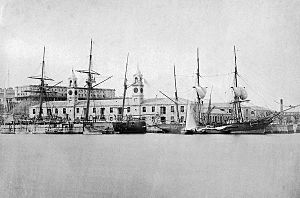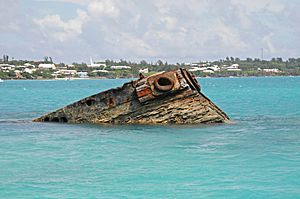HMS Vixen (1865) facts for kids

Vixen (left) and the barque Nightwatch (right) at Bermuda Dockyard between 1867 and 1873
|
|
Quick facts for kids History |
|
|---|---|
| Name | HMS Vixen |
| Ordered | 22 March 1864 |
| Builder | Charles Lungley, Deptford |
| Cost | £54,193 |
| Laid down | 1864 |
| Launched | 18 November 1865 |
| Commissioned | 1866 |
| Fate |
|
| General characteristics | |
| Displacement | 1,228 tons |
| Tons burthen | 754 bm |
| Length | 160 ft (49 m) pp |
| Beam | 32 ft (9.8 m) |
| Draught | 11 ft (3.4 m) maximum |
| Installed power | 740 ihp (550 kW) |
| Propulsion |
|
| Sail plan | Barquentine rig (removed 1873) |
| Speed | 8.9 kn (16.5 km/h) |
| Range | 1,080 nmi (2,000 km) at maximum speed |
| Complement | 80 |
| Armament | |
| Armour | 4.5 in (11 cm) iron belt and bulkheads on 10 in (25 cm) of teak |
HMS Vixen was a special kind of warship called an armoured gunboat. She was the only ship of her type and the third ship in the Royal Navy to be named Vixen. What made her really stand out was that she was the very first Royal Navy ship to have two propellers!
Contents
Ship Design and Features
Vixen was designed by the Admiralty, the group in charge of the Royal Navy. She was built as an experimental ship, meaning she was used to test new ideas. She was like a "half-sister" to two other experimental ships, Viper and Waterwitch. While Viper and Vixen both had two propellers, Waterwitch used a unique water-pump system to move. Viper was mostly made of iron, but Vixen had a mix of materials.
Her Strong Hull
Vixen was an armoured gunboat, built to be very strong. Her hull, which is the main body of the ship, was made using a mix of iron and wood. She had iron frames and iron sides, but her outer layer was covered with thick teak wood. A strong, armored area inside protected her engines and other important parts. Her front, called a ram bow, was also reinforced with heavy iron. This was designed so the ship could ram into enemy vessels. To stop sea creatures from growing on the bottom, her underwater hull was covered in copper. She also had special openings at the back to lift her propellers out of the water. This helped her sail better when she was only using wind power.
How She Moved
Vixen had two powerful steam engines. Each engine turned one of her two propellers, which were about 9 feet wide. Together, these engines produced 740 horsepower. This power allowed her to reach a top speed of about 8.9 knots (about 16.5 kilometers per hour). Steam for the engines came from two large boilers.
Sails and Rigging
When she was first built, Vixen had a barquentine rig, which means she had sails. However, in 1873, all her masts, ropes, and other sailing equipment were removed. This happened because it was decided that Vixen and her sister ship Viper would stay permanently in Bermuda.
Her Weapons
Vixen was armed with two large 7-inch guns. These were muzzle-loading guns, meaning they were loaded from the front. She also had two smaller 20-pounder guns, which were loaded from the back. One of the 7-inch guns from either Vixen or Viper was still on display in St. George's, Bermuda as recently as 1991.
Building and Early Life
Vixen was ordered on March 22, 1864, from a builder named Charles Lungley in Deptford. She was started that same year and launched into the water on November 18, 1865. She officially joined the Royal Navy in 1866. Her total cost was £54,193, which was a lot of money back then!
Her Time in Service
Vixen, Viper, and Waterwitch took part in special tests in the late 1860s. They wanted to see how well these experimental ships performed. While they could turn very well, none of them could go faster than about 9.5 knots. This was quite slow compared to other ships like Warrior, which could reach 14.5 knots.
In 1876, Vixen almost sank during a winter storm in the Irish Sea. This showed she wasn't very good for sailing in rough open waters. Because of this, Vixen and Viper were towed to Bermuda in 1868. There, they were used as floating defense ships inside the coral reefs, protecting the Royal Naval Dockyard, Bermuda.
In 1869, both ships helped move a large floating dock called Bermuda. In 1870, Vixen even rescued a disabled sailing ship. After her masts were removed in 1873, she was better able to survive a big hurricane in 1878. This storm caused a lot of damage to the dockyard. By 1895, Vixen was being used as a place for dockyard workers to live.
Her Final Resting Place
In December 1895, Vixen was sold to a local company that dealt in scrap metal. However, she wasn't completely scrapped. In 1896, it was decided that she should be sunk in a channel to block it off. This would force any enemy torpedo boats to pass closer to shore batteries, making them easier to target.
After her engines were taken out, Vixen was placed across a narrow gap in the reef called Chubb Cut. Explosives were then used to break her keel, and she sank to the bottom. Today, Vixen lies in about 10 meters (33 feet) of water, not far from Daniel's Head at the west end of Bermuda. Her bow, or front part, is still just above the water. She is very well known in Bermuda and is a popular spot for glass-bottomed boat tours and divers. She has become a cool tourist attraction! You can even see her wreck on satellite maps.
Exploring the Wreck
In 1986, a professor named Richard Gould started studying the wreck of Vixen. He worked with volunteers and received help from the Bermuda Maritime Museum. By 1988, they had spent 13 weeks diving at the site. In 1991, Professor Gould published a detailed report about the ship's construction, history, and how she ended up on the seabed.
Images for kids


